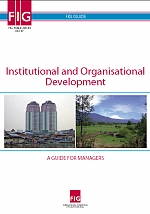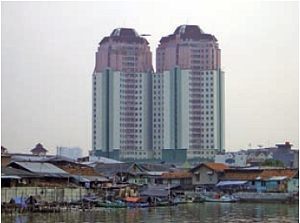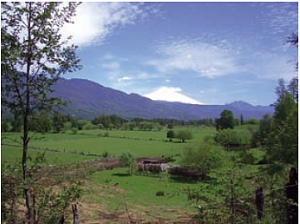Terminology
(a) Capacity, Capacity Building and Sustainable Organisations
UNDP (1998)
offers this basic definition of capacity: “Capacity can be defined as the
ability of individuals and organizations or organizational units to perform
functions effectively, efficiently and sustainably.”
UNDP (1997)
has also provided the following definition of capacity development: “the
process by which individuals, organisations, institutions and societies develop
abilities (individually and collectively) to perform functions, solve problems
and set and achieve objectives.”
Capacity building consists of the key components of capacity assessment and
capacity development. Sufficient capacity needs to exist at three levels: a
societal (systemic) level; an organisational level; and an individual level,
with all three needing to be in place for capacity to have been developed.
So what is a sustainable organisation? From these definitions, it is one
which:
- Performs its functions effectively and efficiently;
- Has the capability to meet the demands placed on it; and
- Continuously builds its capacity and capability so that it can respond
to future challenges.
Such an organisation needs to assess its capacity honestly and objectively,
and to give focused attention to capacity development. The emphasis on
sustainability is vital: unless capacity is sustainable, an organisation cannot
respond effectively to the ongoing demands placed on it.
(b) Institutional and Organisational Development
For the purposes of the work of the Task Force, institutional development
relates to the enhancement of the capacity of national surveying, mapping, land
registration and spatial information agencies and private organisations to
perform their key functions effectively, efficiently and sustainably. This
requires clear, stable remits for the organisations being provided by government
and other stakeholders; these remits being enshrined in appropriate legislation
or regulation; and appropriate mechanisms for dealing with shortcomings in
fulfilling the remits (due to individual or organisational failure). Putting
these elements in place requires agreement between a wide range of stakeholders,
in both the public and private sectors, and is a non-trivial task.
Organisational development, in contrast, relates to the enhancement of
organisational structures and responsibilities, and the interaction with other
entities, stakeholders, and clients, to meet the agreed remits. This requires
adequate, suitable resourcing (in staffing and cash terms); a clear and
appropriate organisational focus (to meet the agreed remit of the organisation);
and suitable mechanisms to turn the focus into delivery in practice (these
mechanisms including organisational structures, definition of individual roles,
and instructions for completing the various activities).
One useful and succinct model for putting in place suitable measures to
enable and underpin organisational success is that developed by the
UK Public Services
Productivity Panel (HMT, 2000). This recognises five key elements which need
to be in place:

Self-assessment
The Task Force developed a model for assessing capacity, by considering six
different tasks, each at the systemic, the organisational and the individual
level:
- The development of appropriate land administration policy and
legislation;
- The conversion of those policies and legislation into strategies,
systems and programmes;
- Agreeing the split of activity between different stakeholders;
- The production of the necessary outputs (for instance, accurate and
current surveys, land registers and valuation lists);
- The effective use of those outputs; and
- Ensuring effective learning and improvement.
The Task Force then created an assessment template, providing four statements
for each of 18 areas (each of the six elements above, at each of the three
levels). Respondents were asked to rank the statements 1-4 in terms of how well
the statements reflect the situation in their country/ state, or to mark the
statement in each group of 4 which most closely resembled the situation in their
country/ region.
The template can be used by individuals and
organisations in the assessment of their strengths and areas for development
Findings
The table below provides an overview of the responses (where the most
often-selected response is shown, 1 being the ‘worst’ description and 4 being
the ‘best’ description).
| |
Societal |
Organisational |
Individual |
| Policy development |
4 |
3 |
3 |
| Conversion into programmes |
3 |
3 |
2 |
| Division of work |
1 |
3 |
2 |
| Producing outputs |
2 |
3 |
3 |
| Use of outputs |
2 |
3 |
3 |
| Learning |
3 |
3 |
2 |
A textual summary of the results is that:
- The organisational section scores best, with the third answer being
selected in all six areas;
- In the institutional section, the worst answer is selected once and the
second answer two times. Despite the best answer being selected once, it is
last choice for very many respondents;
- In the individual section, the second answer is selected three times and
the third answer three times;
- The area scoring best is policy development;
- The area scoring worst is agreeing the division of labour between
stakeholders at the various levels.
Recognising the constraints set out in the previous section, the Task Force
examined the responses, including the textual responses of specific issues which
hamper organisational capacity in the views of the respondents, and came to the
view that the following broad conclusions could be drawn from the responses:
- Cooperation between organisations is a weak point, with cooperation
instead being suspicion in some cases, and the remits and skills of the
different organisations not joined up effectively;
- Effective working across sectors is a particular issue brought forward
in the free-form comments;
- There are skill gaps declared, particularly in the conversion of policy
into programmes, the division of labour, and ensuring effective learning and
development;
- Stakeholder requirements appear insufficiently understood/
insufficiently balanced when turning to ensuring effective use of outputs;
- There is insufficient time and effort given to learning from past
experience.
The Task Force also considered a number of other publications concerning land
administration policy guidelines, including those from the
UN FAO (2007),
AusAID (2008) and
Land Equity International (2008)
Key components
From its work, the Task Force developed the following list of key components
which need to be in place in a sustainable organisation, and which are often not
in place:
- Make clear statements defining the responsibilities of each level/
sector
- Provide transparent leadership ‘from the top’ to encourage collaboration
in both top-down and bottom-up ways
- Define clear roles for the different sectors, including the private
sector
- Establish a clear organisational culture that supports a cooperative
approach amongst individual employees
- Ensure that the network of individuals and organisations has a
sufficient voice with key decision makers for land administration issues to
be taken fully into account in all central policy making
- Facilitate policy development and implementation as a process that is
open to all stakeholders, with all voices being clearly heard
- Provide a legal framework that enables the use of modern techniques and
cross-sector working
- Offer relevant training courses that clearly explain, encourage and
enable cooperative and action-based working by organisations, within a
clearly understood framework of the roles of each level/ sector
- Share experiences through structured methods for learning from each
others’ expertise and experiences, with this learning fed back into
organisational learning
The Guide
The Guide considers each component in turn, and for each one provides:
- Some context
- A description
- A vision of a sustainable organisation
- Examples
- Key questions
The examples are drawn from all parts of the world.
Links, reports and presentations
The core membership of the Task Force:
Iain
Greenway – Chair
United Kingdom |
Chief Executive of a National Mapping
Agency |
Santiago Borrero
Mutis
Colombia |
Secretary General, Instituto Panamericano
de Geografia e Historia (IPGH), with significant experience as a senior
manager in surveying organisations in developing countries; a former
chair and current Board member of the GSDI Association |
Teo Chee
Hai
Malaysia |
Past President, the Institution of
Surveyors Malaysia; Past Secretary General, ASEAN Federation of Land
Surveying and Geomatics. Chartered & Licensed Surveyors |
John Parker
Australia |
Former Surveyor General; ex-Chair of
Commission 1 |
Richard
Wonnacott
South Africa |
Senior Manager of a Mapping Agency |
Spike
Boydell
UK/Australia |
Professor of Built Enviroment, School of
Built Environment, University of Technology Sydney; ex-Vice Chair of
Commission 8 |
Contacts
|




























